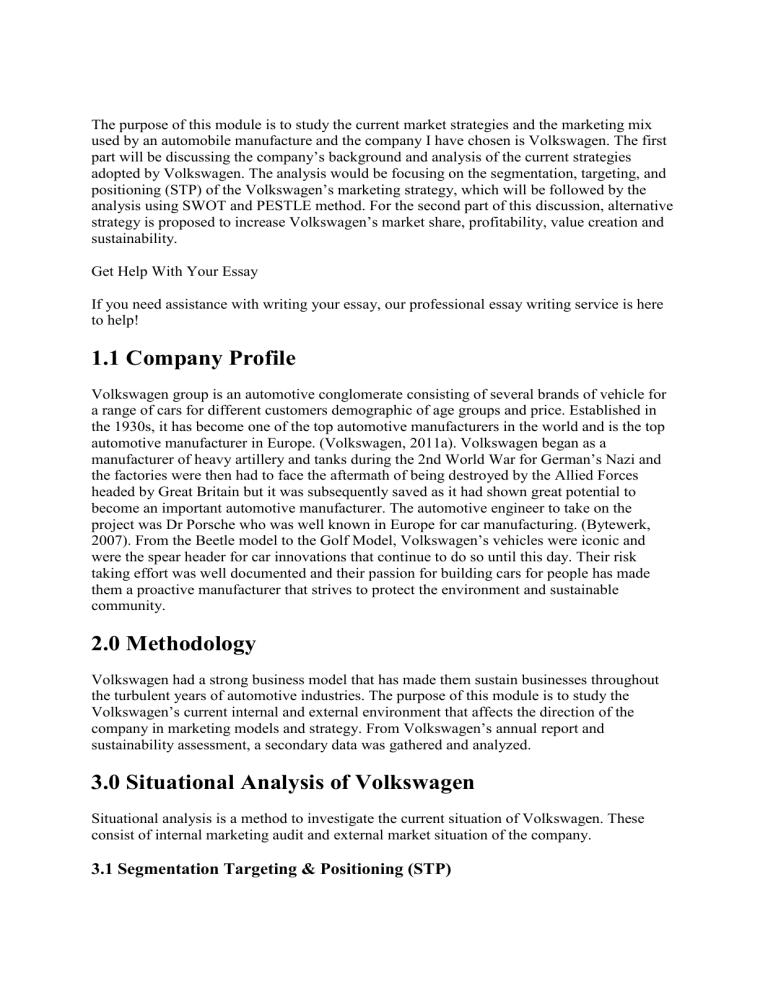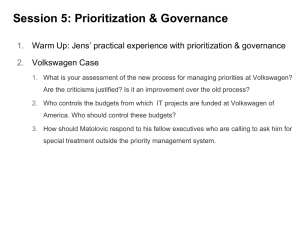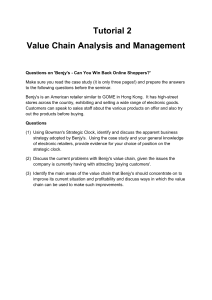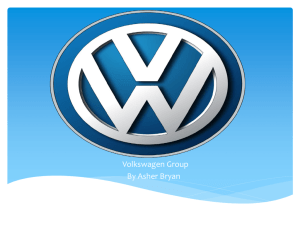
The purpose of this module is to study the current market strategies and the marketing mix used by an automobile manufacture and the company I have chosen is Volkswagen. The first part will be discussing the company’s background and analysis of the current strategies adopted by Volkswagen. The analysis would be focusing on the segmentation, targeting, and positioning (STP) of the Volkswagen’s marketing strategy, which will be followed by the analysis using SWOT and PESTLE method. For the second part of this discussion, alternative strategy is proposed to increase Volkswagen’s market share, profitability, value creation and sustainability. Get Help With Your Essay If you need assistance with writing your essay, our professional essay writing service is here to help! 1.1 Company Profile Volkswagen group is an automotive conglomerate consisting of several brands of vehicle for a range of cars for different customers demographic of age groups and price. Established in the 1930s, it has become one of the top automotive manufacturers in the world and is the top automotive manufacturer in Europe. (Volkswagen, 2011a). Volkswagen began as a manufacturer of heavy artillery and tanks during the 2nd World War for German’s Nazi and the factories were then had to face the aftermath of being destroyed by the Allied Forces headed by Great Britain but it was subsequently saved as it had shown great potential to become an important automotive manufacturer. The automotive engineer to take on the project was Dr Porsche who was well known in Europe for car manufacturing. (Bytewerk, 2007). From the Beetle model to the Golf Model, Volkswagen’s vehicles were iconic and were the spear header for car innovations that continue to do so until this day. Their risk taking effort was well documented and their passion for building cars for people has made them a proactive manufacturer that strives to protect the environment and sustainable community. 2.0 Methodology Volkswagen had a strong business model that has made them sustain businesses throughout the turbulent years of automotive industries. The purpose of this module is to study the Volkswagen’s current internal and external environment that affects the direction of the company in marketing models and strategy. From Volkswagen’s annual report and sustainability assessment, a secondary data was gathered and analyzed. 3.0 Situational Analysis of Volkswagen Situational analysis is a method to investigate the current situation of Volkswagen. These consist of internal marketing audit and external market situation of the company. 3.1 Segmentation Targeting & Positioning (STP) Volkswagen’s strategy is to cater to all different age demographic, price and needs. Unlike most vehicle manufacturer that comes with a single or two model that try to pleases the mass market, Volkswagen has set a Product Market Matrix that divides accordingly to these groups: Young, Single and Professionals between the ages of 18-24 years old. Consumer who regards cars/vehicle as ‘status’ differentiator and has specific technical details requirement like LED headlights, Bluetooth enable system. Consumers who have priority for speeds and better run engine for example the V6/V8 engine with higher horsepower capacities. Married Couples with children. Family centric focused on safety features, space and basic family needs like Rear End monitoring system, Crash optimized rear end. Goods transporter for small scale home businesses that maximizes space like foldable seats and Stow and Go storage system. Retired couple who has less emphasis on speed or sleek futuristic design. Consumers who haul equipment that has trailer tow package and Heavy Duty suspension for more rugged and heavy-duty requirements According to the product matrix from Volkswagen Annual Report, efforts and attempt to fill in all the market segment for different needs and lifestyle of the society has been the strategy of Volkswagen International. 3.2 Positioning Volkswagen is the group of company that owned and operated several other automotive arms such as Audi (the luxury brand) including Lamborghini, with competitions like BMW and Mercedes Benz Cars, Scania (heavy trucks and buses), Seat (Spanish Stylish compact cars), Skoda (entry level vehicles such as sedan, hatchbacks), Volkswagen commercial vehicles for transportation of goods and Volkswagen Passengers cars (entry-mid level vehicles). For the purpose of this discussion, we will choose the Volkswagen Passenger Vehicles brand. The main competitors for this range of vehicles are Toyota and Mazda. Toyota is one of the biggest car brand with sales revenue of US$252.1 Billion (Toyota, 2010) while Mazda falls under US$33.3 Billion annual sales (Mazda, 2010). One of the most enduring of Volkswagen effort is to preserve and protects the environment. The main policy of the company is sustainability, responsibility through their manufacturing, products and in the support in educating the communities on the protection of environment. Apart from these initiatives, Volkswagen differs from other vehicle manufacturer in the way the products are more energy efficient and thus reducing the need for more fuel burning. BlueMotion is a technology created by Volkswagen that reduces the sizes of the engine that runs on either petrol or diesel. Smaller engines compared to the conventional engines buts runs better with increased performance and reduced emission of carbon dioxide. Volkswagen is known for their high quality finishes that ensures durability, comfort and ergonomic design with attractive and modern look. Quality in the production also ensures safety and endurance. 3.3 Unique Selling Proposition Volkswagen is the group of company that owned and operated several other automotive arms such as Audi (the luxury brand) including Lamborghini, with competitions like BMW and Mercedes Benz Cars, Scandia (heavy trucks and buses), Seat (Spanish Stylish compact cars), Skoda (entry level vehicles such as sedan, hatchbacks), Volkswagen commercial vehicles for transportation of goods and Volkswagen Passengers cars (entry-mid level vehicles). For the purpose of this discussion, we will choose the Volkswagen Passenger Vehicles brand. The main competitors for this range of vehicles are Toyota and Mazda. Toyota is one of the biggest car brand with sales revenue of US$252.1 Billion (Toyota, 2010) while Mazda falls under US$33.3 Billion annual sales (Mazda, 2010). 3.4 Porter’s Generic Strategies Volkswagen has employed several strategies to remain competitive in the market with segmentation of products to meet different needs and lifestyle of the consumers and ensuring no compromise in the quality of the finishes, safety features and technology to remain ahead of the competitors. 3.5 Marketing Mix for Volkswageb 3.5.1 Product Volkswagen and The Beetle car are known synonymously and has great histories and stories making it one of the most iconic car in the world that sold over 23 Million units. But the biggest selling model of Volkswagen in the market today is the Volkswagen Golf with 7th Generation model since the 1st one in 1974 that has until now selling over 25 Million unit around the world. It has been voted as the runner up European Car of the Year almost every year. But it’s the personalized segmented product in the Volkswagen pipeline that made it successful. From Convertible, Hatchback, Coupe, Sedan, Sports, SUV (Sports Utility Vehicle) and MPV (Multi-purpose Vehicle), the company has the car that fits every lifestyle, needs, and budget of consumers. In Malaysia, the Volkswagen Polo has remained as the most popular model with 5 versions that ranges from Trendline, Comfortline, CrossPolo, Highline and GTI and runs on petrol, diesel to the diesel blue technology. Volkswagen Malaysia has reported strong growth in deliveries, with the total number of units sold in 2012 crossing the 13,000 mark, recording a 77% increase compared to corresponding period in 2011. This follows healthy growth recorded in 2011 with 7,350 units sold. That translates to an estimated market share of 2.4% of Total Industry Volume (TIV), making VW the sixth best-selling marque in Malaysia and the top selling European brand. The brand also launched “Think Blue”, a global platform unifying all activities and initiatives on environmental responsibility, fuel consumption and emissions. 3.5.2 Price Regardless of the ideal positioning of consumer’s needs, pricing is also one of the major criterion is choosing a vehicle. Volkswagen has consistently priced their cars with premium pricing with an average of 10 percent higher than competitors. The return is for more upscale and rewarding ownership experience that translates to brand loyalty. However, with more competitive automotive markets, Volkswagen has been losing market share as consumer perceived the car value is overpriced compared to Asian automotive car manufacture that has better features and equally good safety features like Mazda and Toyota. In fact many American and European automotive factories have been losing out to these competitors and had never recovered resulting in layoffs and eventual shut down. Through vigorous research, Volkswagen has found that the previous models were not as popular because of two reasons; the retail price and the perception of high maintenance costs (Evans, 2011). To counter this Volkswagen has reduced their premium pricing to be only 5 percent above competitors’ products while maintaining their quality and service. Having cars to be manufactured in United States has been the strategy to reduce production cost and thus, reducing the price of their cars. The model Jetta is an example. When the price is reduced, the not so popular model was swapped off the car showroom and became very popular. They have managed to attract consumer who are more price conscious who wants quality. Volkswagen has also decided to take on the approach of more is less. They are going to make bigger cars and charge less for them. They are exploiting this idea with the Jetta and the Passat. They are changing their pricing strategy in hopes of reaching their goal to become the number one automaker company in the world. 3.5.3 Place Volkswagen has increased their dealership from 12 to 22 in the year 2012. The number of showroom throughout the country has also jumped to 28 with the positive increased in sales. With increased market awareness of Volkswagen product throughout Malaysia especially in major towns and cities, road shows in popular shopping malls, and new showrooms. These together with the increased of 3S Centre (Service, Sales and Spare Part) nationwide including Sarawak and soon will be in Kota Kinabalu, Sabah will definitely create consumers’ confidence. 3.5.4 Promotion activities Volkswagen like the other car manufacturer has constantly organized events and road show in malls with contest, promotion and product launch all year long. With the new official website, customers can review prices, found out models , local dealers and service centers of the company. They have also launched promotional activities through social networking sites such as Facebook and Twitter that updates their customers and fans. Hill (1988) stated that advertisement such as sales promotion, road show and other promotion activities will drive awareness of consumer and will affect the purchase intention. Besides, this also supported by Mortimer (2001), advertising campaign done by companies is one of the important tools to gain the brand cognition from consumers. The Volkswagen Motor Club Malaysia is also an active Motor Club that serves to organise activities for Volkswagen enthusiast. 3.6 Ansoff Growth Strategies The Volkswagen already exists a long time ago in the Malaysian’s market. Therefore, market penetration strategy been used in the Malaysian market, is by sales of existing products in existing markets. The market penetration strategy for Volkswagen is to maintain the current position in the Malaysian market, and do a lot of advertising in the automotive industry, in order to promote the market, create consumer awareness, and increase market share (Jobber, 2007). 3.7 Volkswagen PEST Analysis 3.7.1 (P)olitical Political factors will directly affect the operations of Volkswagen. This is because the decisions made ​​by the Government, will affect the daily lives in the form of policy or legislation. For example, if the government increases taxes expenses to support the local car manufacturers such as Perodua, it will directly affect the profits of the Volkswagen. This is because when the increasing in the import duty; compared to local companies, Volkswagen will become more expensive. This will result that Malaysian citizen would not buy a car from Volkswagen, especially those who are in the middle and lower levels of income range. According to Malaysia Import Duty (2000), motor vehicle import tax in Malaysia is more than 120%. 3.7.2 (E)conomics A country’s economy is affected by the country’s unemployment rate. According to the article of Statistic of Malaysia economy (2012), Malaysia’s unemployment rate increased from 3.1% (2011) to 3.2% (2012), this means an increase in the number of unemployed workers. People cannot get a job once the unemployment rate was increase and at the same time mean that an individual will lose their income and this will happen that unaffordable in purchasing. This indicates that sales in the automotive industry in Malaysia will be affected. 3.7.3 (S)ocial Changes in the socio-cultural factors, such as the role of women, education, and professional attitude will affect the business operations of Volkswagen in the automotive industry. Today, the majority of women in society are highly educated, so that the majority of women choose go out to work, instead of sitting at home doing housework and childcare, this results that the income of the family is increasing. According to Thomas and Early Sasser (2001), Customers will never be satisfied with what they have, especially car. The article from Malaysian Automotive Association (2012) stated that there was increase in the total volume of 4,021 units in 2011 (297,203 units) in the first six months to 6 months in 2012 (301,224). With the higher income, car users would like to replace it with a new car and enjoy the latest technology engine performance in the long term. 3.7.4 (T)echnology The progress of science and technology for the Volkswagen Group in R&D projects, the establishment of a more advanced vehicles, such as hybrid cars, in the automotive market, in order to maintain and create competitive advantage. Hence, Volkswagen Group focuses on the development of new technology and innovation, to become the world’s most economical, eco-car manufacturing. As the board of chairman of Volkswagen, Martin Winterkorn, stated that their goal is becoming leadership position in the automotive industry (Annual report 2011). With the advancement of technology, the Volkswagen Group can provide hybrid engine by using electricity to run and allow reducing gasoline consumption and carbon dioxide (CO2) emissions into the environment. In February 2013, Volkswagen has launched a new car, named XL1, which is one of the most fuel-efficient production cars in the world automotive with fuel consumption values ‹0.9/100km (Volkswagen news, 2013). 3.8 SWOT Analysis 3.8.1 (S)trength Global presence Volkswagen operates In 153 countries and regions around the world and is the third largest car manufacturer in 2012. The company produces cars in 100 factories in Europe, North America, South America, Asia, Africa and Oceania. In addition, there is no other car companies have the ability with the public there is competition in the global except GM and Toyota (Strategic Management Insight, 2012). Strong brand portfolio Volkswagen has 13 car brands: Audi, Bentley, Bugatti, Lamborghini, Porsche, Seat, Skoda, Volkswagen, MAN, Scania and other commercial vehicles and sales. With such a wide range of models Volkswagen meet almost all the needs of consumers and access to a huge consumer market (Strategic Management Insight, 2012). Synergy To benefits the Volkswagen Group from synergy created between all 13 independent car brands. All 13 independent companies to save the cost of R & D and services, by learning from each other’s best practices and share distribution channels (Strategic Management Insight, 2012). Well performing brands Without its namesake brand, the company has some other very successful brands, including Audi and Porsche. The value of the Audi brand was $ 70 billion U.S. dollars and Porsche worth $ 5 billion U.S. dollars. Audi is also the second-largest brand in the portfolio of the company’s impressive growth (Strategic Management Insight, 2012). 3.8.2 (W)eaknesses Weak position in the US passenger car market In 2012, Volkswagen passenger car market in the United States, only about 5% market share. The United States is the world’s second largest auto market in the world and weak Volkswagen’s position with their results comparable sales decline (Strategic Management Insight, 2012). Most cars are not environment friendly Volkswagen has three major sports car brand Porsche, Lamborghini and Bugatti with carbon dioxide emissions and fuel inefficient. In addition, the Volkswagen Group’s strong opposition to legislation, carbon dioxide emissions and energy efficiency requires more stringent requirements, because their cars are not as fuel-saving and environment-friendly as its competitors (Strategic Management Insight, 2012). 3.8.3 (O)pportunities Changing customer needs Volkswagen may introduce more fuel-efficient models are also many fewer emissions of carbon dioxide in all automotive brands, to meet new customer needs (green car), and enhance the brand reputation (Strategic Management Insight, 2012). Increasing fuel prices Consumers are very sensitive to fuel prices, the prices go up, and their demand tends to the growth fuel-efficient and hybrid vehicles (Strategic Management Insight, 2012). Positive attitude towards “green” vehicles The cars emit large quantities of carbon dioxide and fuel inefficient cars pollute the air and the negative environmental impacts. Consumers are aware of this negative impact is more positive “green” vehicle emissions of carbon dioxide is much less fuel-efficient (Strategic Management Insight, 2012). Growth through acquisitions So far, the Volkswagen Group is very successful acquisition of other car manufacturers, and greater consumer market, as well as faster than organic growth. To continue at the current rate of growth, and access to important U.S. market, the public should continue to acquire competitors (Strategic Management Insight, 2012). Increasing global demand for buses Bus demand is expected to grow at an annual rate of 5% until 2016. Volkswagen is one of the major bus suppliers have the opportunity to expand production and increase sales (Strategic Management Insight, 2012). 3.8.4 (T)hreats New emission standards The public strongly opposed to the more stringent requirements for low-emission standards. If such legislation is adopted, the company will have to make a huge investment planning, to reduce carbon dioxide emissions from new engines (Strategic Management Insight, 2012). Fluctuating fuel prices Due to the increase in the extraction of shale gas, future fuel prices, hybrid cars are not very attractive. Volkswagen hybrid and electric vehicles of investment losses, rather than the perspective of the car of the future will be considered. On the other hand, soaked in fuel prices will increase the VW cost-conscious consumers are not very attractive, because they need a large number of small cars with low fuel consumption (Strategic Management Insight, 2012). Rising raw material prices Metal prices of raw materials will increase the cost of the car manufacturers, and squeeze the profit of the company (Strategic Management Insight, 2012). Growing euro exchange rate Volkswagen earns more than 70% of the revenue outside the euro area,. Exchange rate fluctuations threat to the profits of the Volkswagen’s profit, if the euro strengthens against other currencies (Strategic Management Insight, 2012). 4.0 Recommendations for Volkswagen 4.1 Recommendation for SMART Objective and Goals Volkswagen had come out an objective called Strategy 2018 which focus on the Volkswagen Group has positioned itself as a global economic and environmental leader among automobile manufacturers. The goal is actually quite clear for Volkswagen which is to make Volkswagen to be to most successful and fascinating automaker in the world by 2018. SMART objective in marketing strategies further been used for identifying the objective and goals. Specific- Volkswagen intends to deploy smart innovation and technology and becoming the world’s leading in customer satisfaction and quality Measurable- The goal is to increase the unit sales to more than 10 million vehicles every year. Achievable- Volkswagen intends to capture the development of a major growth market share than average. Realistic- Volkswagen’s goal is to be the best employer in all brands, companies and regions, it is necessary, in order to build a first-class team. Time bound- Volkswagen clarifies that the goal can be achieved in 2018. (Annual Report, 2011). 4.2 Recommendation for Marketing Strategies and Programs Not only with the strategies mention before, in order to be more competitive advantage in the automobile industry, perceived differentiation be considered. Perceived differentiation is an important factor for determining an SBU’s ability to compete in this industry. With high capacity, an SBU must prove some distinguished difference from competitors in order to compete and succeed, otherwise the SBU will not grow its customer base, become stagnant and eventually be harvested or divested (Levring, 2011), (Clayton, 2011c). Volkswagen passenger cars will able to show differentiation in its product line through unique automotive design and advertising. It was assigned, because it is dependent upon the company image (Volkswagen, 2010b), (Clayton, 2011c). A firm’s differentiation means nothing if all potential consumers think poorly of it (Clayton, 2011c). Find out how UKEssays.com can help you! Our academic experts are ready and waiting to assist with any writing project you may have. From simple essay plans, through to full dissertations, you can guarantee we have a service perfectly matched to your needs. 5.0 Conclusion Volkswagen has taken the strides to move with time from their illustrious past as war vehicle producers to world-class car maker that has trusted reputation for quality and luxury vehicles. From its troubled beginnings to its slow and steady rise to the top of the automotive world, Volkswagen has never forgotten what its soul purpose was: to be the people’s car. The firm’s ability to re-invent itself to customize to consumers’ needs in every level of the society has kept them relevant to the automotive industry. The declining market of European and American produced cars due to the high competitions from Japanese and Korean car-maker has drove many automotive factories to closure but Volkswagen, with their years of experience has kept diligently at bay despite price competition without compromising on quality, service and their true focus on sustaining the environment. The focus and emphasis on progress and development with the responsibility on keeping the environment clean by producing fuel efficient vehicle and sustainable production without sacrificing the earth delicate natural resources. No matter what has happened, Volkswagen has always put the customer first and designed and sold vehicles for them. Volkswagen is a one-of-a-kind automaker and one worth learning more about (Volkswagen, 2011a). Source : https://www.ukessays.com/essays/marketing/the-unique-selling-propositionmarketing-essay.php



